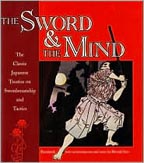Koryu.com Book Reviews

The Sword and the Mind.
Translated by Hiroaki Sato.
Fall River Press, 2004.
ISBN: 9780760765319.
133 p. 7" x 8" hardcover.
Purchase from Amazon. (paid link)
Hiroaki Sato's The Sword and the Mind is a good translation of several of the most important texts of classical Japanese swordsmanship, the Heiho Kadensho, Fudochi Shimmyoroku, and the Taia-ki. These are works that have bearing on more than martial arts, serving as guides to Japanese political, business, and educational leaders for generations.
Sato begins with brief chronologies of Japanese history and Yagyu-related events and continues with an excellent introduction that gives both the socio-historical and philosophical context of Shinkage-ryu strategy and swordsmanship.
He continues with the Heiho kadensho ("Book of the Family Transmission of Swordsmanship") proper, broken into its three constituent sections, "The Shoe-Offering Bridge," "The Death-Dealing Blade," and the "Life-Giving Sword."
These are followed by Takuan's essay, Fudochi shimmyoroku ("Divine Record of Immovable Wisdom"), a long message by the famous Zen priest to Munenori that served as a lesson on the more abstruse elements of swordsmanship and an admonition to Yagyu not to let his position and authority cause him to falter from the True Path. It is a remarkable work for its incisive view of human psychology and the dynamics of interpersonal relationships.
The last section is the Taia-ki (On the Sword of T'ai-a), a further elucidation on the philosophical, and perhaps spiritual, dimensions of swordsmanship when it is used an entity for more than merely killing an enemy, but as a means for living.
Speaking as a student of the Yagyu Shinkage-ryu, there are a couple of places where I think the Sato translation of Heiho kadensho doesn't quite hit the mark. It is not from any lack of skill as a translator, but because he himself doesn't study the art of swordsmanship, and certainly has no firsthand knowledge of Shinkage-ryu theory or methodology. Frankly, I don't think anybody who is not a member of the school can really speak directly to some of the concepts, though Sato certainly comes pretty close.
This is just quibbling on my part, though. If one wishes to read the "real deal," as far as that is possible in a non-Japanese language, this is a good place to start.
Meik Skoss
A Koryu.com original.

Contact Koryu.com
Last modified on October 23, 2019
URL: https://koryu.com /books/swordmind.html
Copyright ©2022 Koryu Books. All rights reserved.
